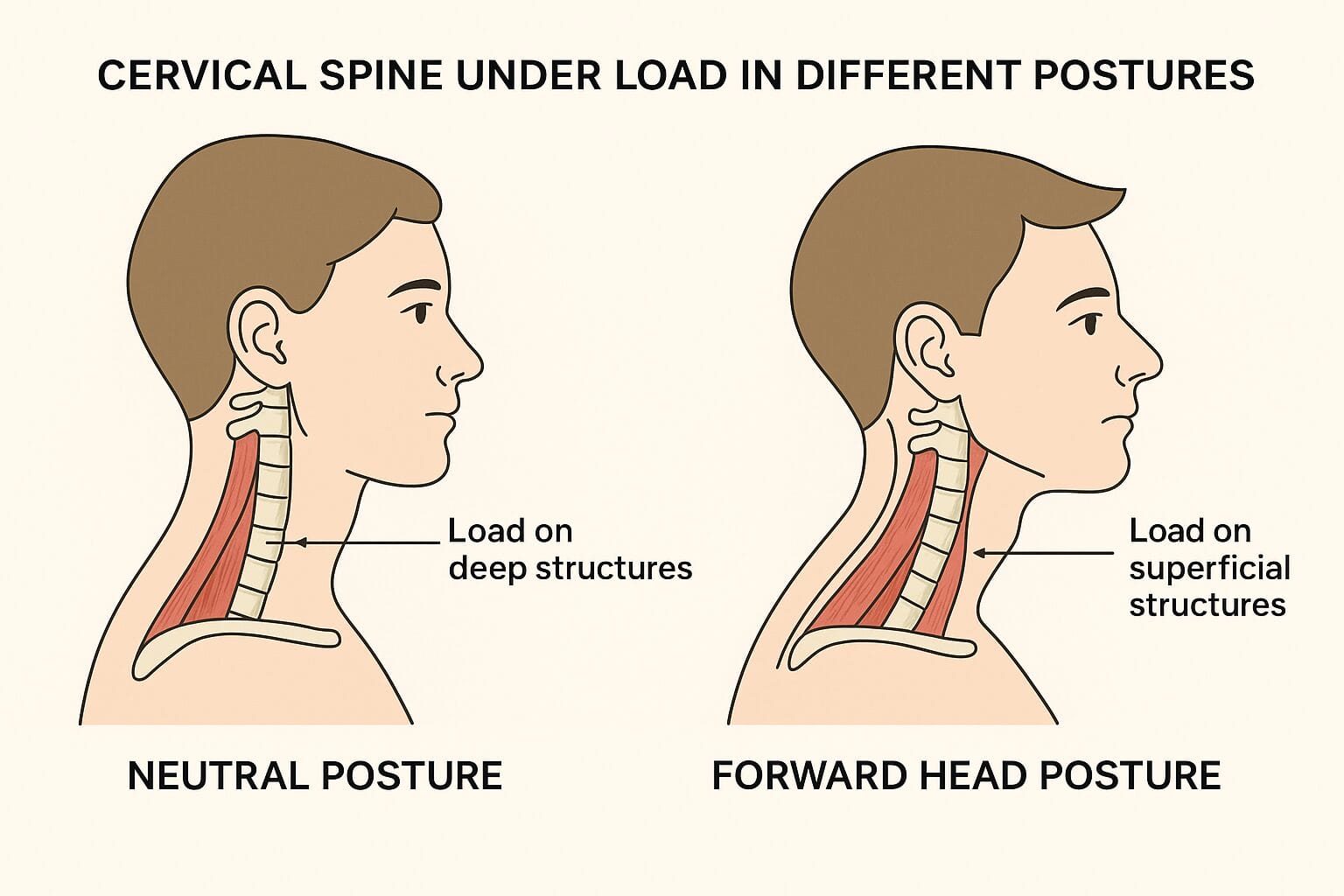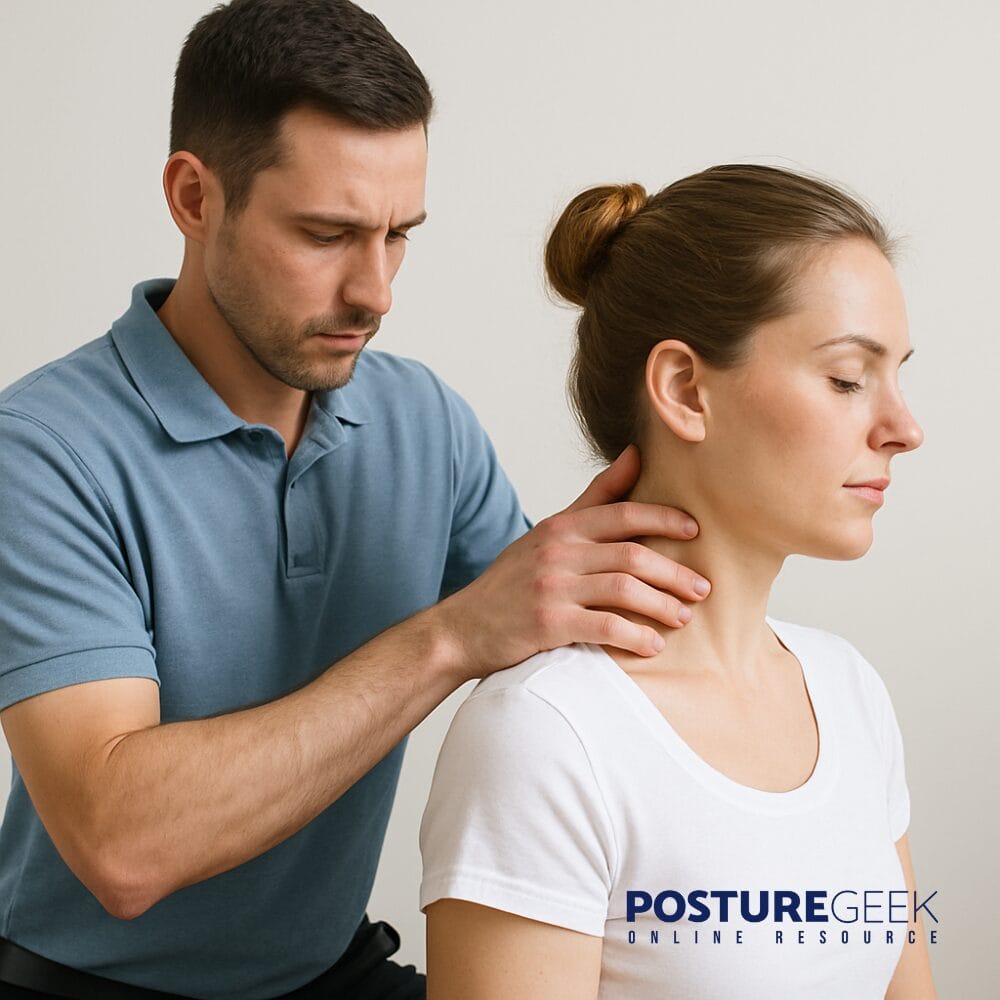Understanding the Deep Neck Muscles: How They Shape Your Posture and Influence the Head, Jaw, and Shoulders
- Updated - April 25, 2025
The deep neck muscles are some of the most important—and least talked about—players in posture and movement health. These small, stabilizing muscles sit close to the spine and skull, quietly supporting everything from head alignment and jaw control to shoulder coordination and spinal balance. The deep neck flexor muscles play a crucial role in maintaining neck core strength and improving posture.
When they’re functioning well, we barely notice them. When they’re not, the effects ripple across the body, often showing up as pain, restriction, or poor movement quality. Over time, imbalances in these muscles can lead to a cascade of secondary issues involving breathing, jaw function, headaches, and even balance. This article looks closer at the deep neck muscles, their unique anatomy, their influence across multiple regions, and the professionals who can help restore their function.
Understanding the Deep Neck Muscles Layers
The deep layer of the neck includes the deep neck flexors (anterior neck muscles), deep neck extensors (posterior neck muscles), and the infrahyoid muscles. These muscle groups lie beneath the more superficial neck muscles like the sternocleidomastoid and trapezius. They are responsible for fine motor control, postural stability, and cervical spine support.
Together, these muscles help maintain cervical alignment and segmental integrity, enabling precise movement and protecting vital neurovascular structures in the neck. Their coordinated function ensures that movements of the head and throat are smooth, balanced, and supported. Dysfunction in any component of this layer can compromise posture, breathing, and vocalization—highlighting the need for an integrated approach to assessment and care.
Anatomy of the Deep Neck Muscles

Deep Neck Muscles: Flexors
These include the longus colli and longus capitis (also referred to as the deep cervical flexors). These muscles are found along the cervical spine’s front (anterior aspect), deep to the trachea and esophagus, and just anterior to the vertebral bodies. They run from the upper thoracic vertebrae and lower cervical vertebrae up toward the base of the skull.
- Longus colli: Flexes and stabilizes the cervical spine. It acts as an anterior counterbalance to the stronger posterior extensors.
- Longus capitis: Connects the cervical vertebrae to the skull and supports head flexion and alignment.
These muscles play a pivotal role in maintaining a neutral head posture. They are often underactive in individuals with forward head posture, and restoring their function is central to postural retraining programs.
Discover a practitioner near you.
Looking for a practitioner near you? Our extensive network of qualified professionals is here to help you.
Deep Neck Muscles: Extensors
These muscles are located deep in the posterior aspect of the neck, running along the spine from the upper thoracic vertebrae to the base of the skull. They lie beneath the splenius and trapezius muscles, forming a critical part of the transversospinalis group that stabilizes and controls the segmental motion of the cervical spine. Part of the transversospinalis group, including:
- Semispinalis capitis
- Semispinalis cervicis
- Multifidus
These muscles extend the head, maintain cervical lordosis, and control segmental spine motion. They provide fine-tuned control over vertebral positioning, ensuring smooth coordination during motion. Deep neck extensors often lead to poor posture, compensatory overuse of superficial muscles like the upper trapezius, and upper cervical strain when weak or fatigued.
Suboccipital Muscles
- Rectus capitis posterior major and minor
- Obliquus capitis superior and inferior
Located at the base of the skull, these four small muscles specialize in fine-tuning head movement. They assist with extension, rotation, and lateral tilt of the head. Rich in proprioceptors, they help regulate balance and spatial orientation. Dysfunction can contribute to tension headaches, dizziness, and postural distortion.
Scalene Muscles (Anterior, Middle, Posterior): Lateral neck muscles
- Attach from the cervical vertebrae to the first and second ribs.
- Support lateral flexion and rotation of the neck.
- Act as accessory breathing muscles, especially during upper chest breathing patterns.
Overactivity or tightness in the scalenes can contribute to thoracic outlet syndrome, brachial plexus compression, and restricted rib mobility, affecting both posture and respiratory efficiency.
Splenius Capitis and Cervicis
- Extend and rotate the head and neck.
- Located more superficially than the transversospinalis group, they often compensate when deep muscles are underactive.
Overuse can lead to postural fatigue and stiffness, particularly in individuals with sedentary habits or unbalanced training routines.
Semispinalis Cervicis and Capitis
- Deep extensors are responsible for head and cervical extension.
- Work in tandem with suboccipital and splenius muscles to support upright alignment and dynamic head control.
They play a critical role in re-establishing the cervical curve after prolonged flexion or forward head habits.
Infrahyoid Muscles (Strap Muscles)
- Include sternohyoid, sternothyroid, omohyoid, and thyrohyoid.
- Depress the hyoid bone and larynx during swallowing and speech.
Though often overlooked in postural conversations, they influence fascial continuity between the throat, jaw, and chest. Dysfunction can subtly affect jaw mechanics, vocal quality, and upper cervical mobility.
How Deep Neck Muscles Influence the Body

Head and Neck Control
These muscles anchor and guide the head atop the spine. When weakened or overcompensated by superficial musculature, it becomes difficult to maintain head alignment. This weakness can lead to forward head posture, reduced cervical range of motion, and an over-reliance on passive structures like ligaments and discs.
Jaw Function and TMJ Health
Poor cervical posture can distort the resting position of the mandible. Tension in the upper cervical spine and anterior neck can change the orientation of the temporomandibular joint, contributing to dysfunction, clicking, and pain. Integrating cervical stability into TMJ treatment improves outcomes.
Shoulder Girdle Coordination
The neck and shoulders operate as a single kinetic system. Imbalances in the deep neck muscles influence scapular control and upper limb mechanics. For instance, instability in the cervical spine may lead to elevated shoulders, restricted thoracic rotation, and compensatory arm tension.
Nervous System and Proprioception
Deep neck muscles, especially the suboccipitals, provide dense proprioceptive input to the brain. They influence balance, coordination, and spatial orientation. Dysfunction may manifest as dizziness, poor postural reflexes, visual strain, or tension headaches.
Postural Implications of Deep Neck Muscles Dysfunction

Neck Pain
Chronic or recurring neck pain is one of the most common outcomes of deep neck muscle dysfunction. When these muscles are weak, fatigued, or imbalanced, they fail to support the cervical spine adequately. This often leads to compensatory overuse of superficial muscles, joint irritation, and muscular tension, which can manifest as persistent neck pain. Pain may radiate to the shoulders or upper back in some cases, and activities like reading, working at a computer, or sleeping in poor positions can exacerbate symptoms.
Forward Head Posture (FHP)
Weak, deep flexors allow the head to drift forward, increasing demand on the posterior neck and upper thoracic region. Over time, this contributes to muscular strain, cervical disc stress, and reduced breathing efficiency.
Upper Cross Syndrome
This pattern involves tightness in the upper traps and pectorals, alongside weakness in the deep neck flexors and lower scapular stabilizers. It results in a hunched upper body, restricted shoulder mobility, and shallow breathing patterns.
Cervicogenic Headaches
Suboccipital hypertonicity can compress nerves at the base of the skull, leading to referred pain in the forehead, temples, or behind the eyes. These headaches are often posture-induced and aggravated by prolonged screen use or stress.
TMJ Dysfunction
The position and movement of the cervical spine directly impact jaw alignment. If the head is chronically tilted forward or rotated, it changes joint loading in the TMJ, often exacerbating clenching, clicking, and discomfort.
Shoulder Dysfunction
Without adequate neck stabilization, scapular control deteriorates. This change can lead to impingement syndromes, reduced overhead mobility, and increased risk of rotator cuff strain. Coordinated function between cervical and thoracic stabilizers is essential for shoulder health.
Deep Neck Muscles Issues: Who Can Help, and How

Physiotherapists
Provide comprehensive assessment and targeted exercise to improve neck strength, coordination, and proprioception. Physical Therapists often use manual therapy to release overactive tissues and retrain neuromuscular patterns.
Rolfing / Structural Integration Practitioners
Use fascial manipulation and postural re-education to balance structural tension. These sessions often reveal deeper holding patterns contributing to neck strain.
Chiropractors / Osteopaths
Perform spinal adjustments to improve alignment and relieve pressure on irritated joints and nerves. Some may also incorporate soft tissue therapy and postural education.
Massage Therapists
Target muscular tension and trigger points, especially in the scalenes, suboccipitals, and upper trapezius. Regular sessions can improve circulation and reduce pain.
Pilates / Movement Educators
Teach spinal and core control through mindful movement, breathwork, and alignment cues. Pilates is especially effective at integrating cervical stability with thoracic and pelvic control.
Alexander Technique Practitioners
Work holistically to improve head-neck-back integration. They focus on movement quality, balance, and reducing unnecessary effort in daily activities.
Finally
The deep neck muscles are foundational to posture, movement, and head-to-body integration. They influence everything from breathing and jaw alignment to balance, coordination, and shoulder control. When neglected, dysfunction in these small but mighty muscles can ripple across the body, often showing up in places we least expect.
With proper professional support, intentional movement practices, and improved postural awareness, restoring the function of the deep neck muscles and reclaiming fluid, pain-free movement is possible. Focusing on the unseen muscles can transform posture from a struggle into a strength.
Resources
Articles:
Do Longus Capitis and Colli Really Stabilise the Cervical Spine? A Morphometric Analysis
- Authors: E. Kennedy, M. Albert, and H. Nicholson
- Summary: This study investigates the anatomical and biomechanical roles of the longus capitis and longus colli muscles, commonly referred to as deep cervical flexors. The authors analyze their fascicular morphology and estimate their force-generating capacities, providing insights into their potential for cervical spine stabilization.
- Read More
Suboccipital Muscles, Forward Head Posture, and Cervicogenic Dizziness
- Author: Yun-Hee Sung
- Summary: This review explores how structural and functional changes in the suboccipital muscles, often resulting from forward head posture, can lead to cervicogenic dizziness. It emphasizes the role of these muscles in proprioception and their contribution to balance and spatial orientation.
- Read More
Effect of Maitland Mobilization Versus Deep Cervical Flexor Muscle Training on Proprioception in Adults with Chronic Mechanical Neck Pain: A Randomized Controlled Trial
- Authors: Fatma Sadeek Amin, Nabil Mahmoud Abdel-Aal, and Ban Saleh El Shater
- Summary: This randomized controlled trial compares the effects of Maitland mobilization and deep cervical flexor muscle training on proprioception in adults with chronic mechanical neck pain. The study finds that both interventions improve proprioception, with implications for managing neck pain and associated postural issues.
- Read More
Characteristics of Head and Neck Alignment and Function of Deep Cervical Flexor Muscles in Patients with Nonspecific Neck Pain
- Summary: This study examines the relationship between head and neck alignment and the function of deep cervical flexor muscles in patients with nonspecific neck pain. It highlights the importance of these muscles in maintaining proper posture and suggests that their dysfunction may contribute to neck pain.
- Read More
PLEASE NOTE
PostureGeek.com does not provide medical advice. This information is for educational purposes only and is not intended to be a substitute for professional medical attention. The information provided should not replace the advice and expertise of an accredited health care provider. Any inquiry into your care and any potential impact on your health and wellbeing should be directed to your health care provider. All information is for educational purposes only and is not intended to be a substitute for professional medical care or treatment.
About the author
Join our conversation online and stay updated with our latest articles.
Find Expert Posture Practitioner Near You
Discover our Posture Focused Practitioner Directory, tailored to connect you with local experts committed to Improving Balance, Reducing Pain, and Enhancing Mobility.
